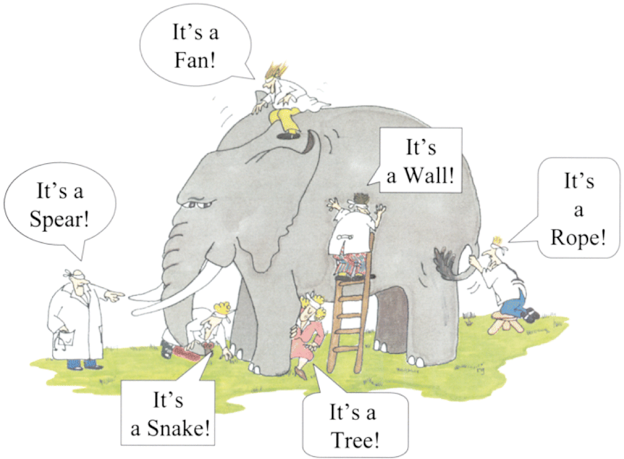Four blind men came upon an elephant in the forest.
They had never experienced this massive creature before. Slowly, they each reached out and touched a different part of the elephant.
“It’s like a snake,” one man said as he felt the long, supple trunk.
“No, it’s a column,” pronounced another, leaning on the muscular leg.
Another jumped back as he heard the animal’s cry. “It’s piercing, like a trumpet.”
The elephant began to move. The fourth man stood, frozen as the ground shook: “It’s an earthquake!”

This ancient parable from the Indian subcontinent has been passed down in many different forms. But the moral is almost always the same:
We often think our own, partial experience represents the full truth, even though other people have different experiences and truths.
Everything is a system
The elephant story is a reminder to approach life with empathy; to step into other people’s shoes, whenever possible.
It’s also great way to understand the business methodology called systems thinking, which is based on the book, Thinking in Systems, by Donella H. Meadows.
Systems thinking isn’t just for business or manufacturing geeks.
Just like the Theory of Constraints, it’s a powerful principle that can be applied to work, life, or just about anywhere you want to level up.
Before we talk about how to apply this theory, here are 3 core principles to understand:
- Everything is a system: a product, team, market, process, habit, personal routine — even an elephant.
- To understand (and improve) the system, you have to understand each part, and how the parts connect. Clearly, an elephant is much more than a trunk, legs, and a trumpeting cry.
- If you can’t see or experience the full system, you need to create models to put it all together. It’s the only way to know your elephant.
Our product, Jotform, is a system that serves nearly 4 million users. All these people use it in different ways, for different purposes.
At the same time, our mission is to provide an exceptional, easy-to-use product — and to continually improve how we serve our customers.
That’s where I started 12 years ago, and it’s what brings our 110 employees to work every day.
In order to fulfill our mission, we have to develop models that represent each user’s point of view. So, our research team talks to at least 20 customers per month.
Then they spend a whole day with each different product team. They describe what the customer does, how they use Jotform, and what they need to accomplish.
Next, we ask one key question: how can we improve the system (product) to solve more problems for this user?
That’s what systems thinking means for us. Of course, it also applies to internal processes, such as how our developers work or how we hire new staff.
Once you find the causes and effects in your system, you can use them to your advantage.
You can harness feedback loops (such as talking to your customers, clients, or even analyzing your own processes) to scale up or down — and improve your results.
How to apply systems thinking
1. Understand and leverage feedback points
Your first goal is to understand the system. What are the feedback or leverage points that affect how it operates?
Once you know the leverage points, you can adjust the system.
If you want more of what the system is producing, you add more power to those feedback points. If you want to prevent or slow production, you exhaust those same points.
Think about a bathtub. The faucet and drain are the leverage points. If you turn on the water but don’t close the drain, water will keep flowing and the tub will never fill.

If you want more water, turn on the faucet and close the drain. If you want to lower the water level or empty the tub, turn off the faucet and open the drain. It’s that simple.
Maybe you want to run faster, instead of jogging at the same five-mile-an-hour pace. What will increase your speed?
Perhaps you need to run more often. Or, you could add interval training, work with a coach, or fine-tune your nutrition.
Once you find your own leverage points, you can get more of what you want (speed) and work the system.
2. Look for patterns and trends
As you seek to improve the system, patterns and trends are like crossword puzzle clues. They give you hints and shift your thinking.
Ideally, they even point you in unexpected directions; to places, people or ideas you hadn’t considered before.
Our developers and data scientists create custom tools to help us see usage patterns. We now have over 50 different charts across multiple dashboards.
We review the charts weekly, and when something unexpected happens, we ask why. Our product (system) and our customers are always evolving.
Watching for trends and patterns help us to stay on top of these changes.
3. People problems vs. system problems
Most problems — from product flaws to poverty to transit inefficiencies — are system problems.
Even when people act inappropriately or struggle in a way that seems preventable, an underlying system is usually to blame.
If your small business is growing too slowly, it’s probably not because of you. There’s a system that should be optimized, whether it’s at the core of your product or service, or a sales process needs work.
Once you’ve examined the system, it’s time to look at people. Maybe a new hire is causing a backlog or a team’s poor communication is wreaking havoc with the system.
Moving someone into a new role could be your leverage point.
Even when people are the problem, there’s usually a systems-based solution. For example, our Ankara, Turkey office takes frequent bike trips together.
Organizing over 70 people isn’t easy, and when some employees headed out early, it messed with our shared schedule.
So, we posted an office administrator near the elevator who reminded everyone that would leave together at 11 — and not before. This quick system change (using a simple leverage point) solved the problem.
Never stop learning
Systems thinking teaches you to see how people, policies, organizations, decisions, relationships, and ideas are interconnected.

If you want to go deeper, The Fifth Discipline: The Art & Practice of The Learning Organization by Peter M. Senge is one of the best books you can add to your nightstand.
As the title suggests, Senge shares five disciplines that ensure learning is embedded your DNA — whether you’re starting a business, leading a whole company, or working inside an organization.
1. Personal mastery
Attend conferences, take online courses, read books and blog posts, listen to podcasts, talk to people inside and beyond your industry, learn from your colleagues, watch documentaries, and do everything you can to improve your skills and stretch your mind.
2. Explore your biases and assumptions
The blind men in the parable all made assumptions about the elephant. Biases and assumptions prevent us from understanding the whole animal. They prevent growth and can block innovation. Being aware of your biases starts internally, but it’s also a hands-on practice.
At Jotform, we test our assumptions with usability tests, customer interviews, support calls, and bootcamp-style onboarding that pairs new employees with long-term staff.
We’re making the product, but we stay curious about how people use it and what they need.
3. Establish a (shared) vision
Systems break down without a clear goal or mission. You won’t run faster if you don’t know why you’re trying to break the speed barrier.
Is it for your own satisfaction? To win a race? To stay strong and fit as you age? Vision keeps you motivated.
In an organization, everyone needs to share that vision. We all know what we’re trying to accomplish with JotForm.
Hosting Friday demo days is one way to ensure we’re all in the same boat. We build that vision into our culture, and keep it alive both in theory and in practice.
4. Learn in teams

Shared learning is powerful. When groups work together to achieve significant goals, it solidifies understanding. It etches the lesson into our minds.
In an organization, this could take the form of working in cross-functional teams, sharing information across contrasting roles, running hack weeks, and running demonstrations.
5. Think in systems
Here’s where it comes full circle. Systems thinking is all about continuous improvement.
It’s also linked to the Iceberg Principle, which states that visible events are tiny compared to what’s happening below the surface. There’s far more ice below the water than you can perceive above it.
When you’re facing a challenge or an opportunity, consider the system.
Get to know the details. Find the leverage points. Test, learn, adapt, and keep refining your models.
After all, if you meet an elephant in the forest, you need to know what you’re facing.









































































Send Comment:
1 Comments:
More than a year ago
Thanks for the blog on systems thinking, this is the exact piece of information i was looking for.